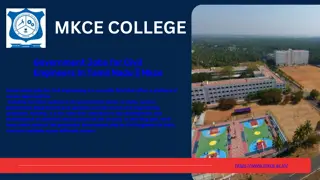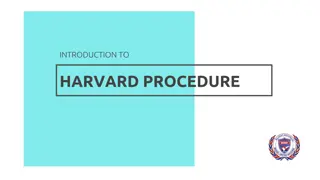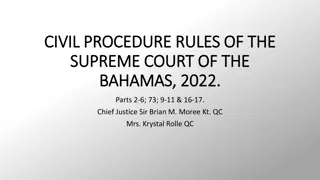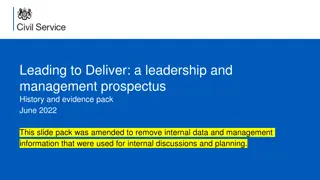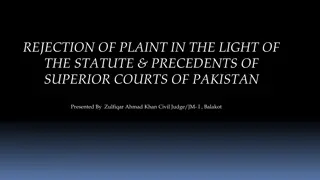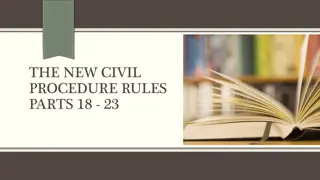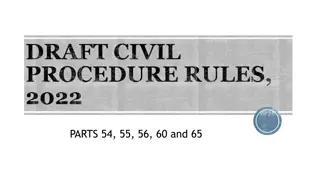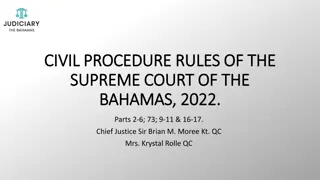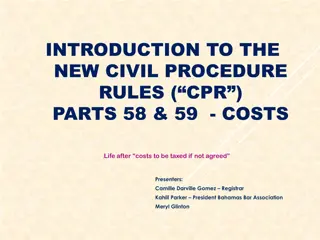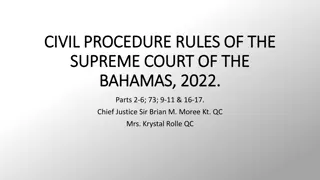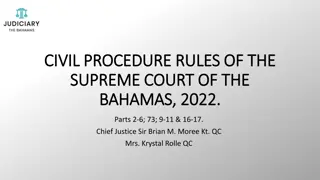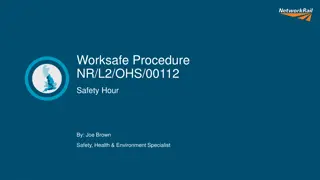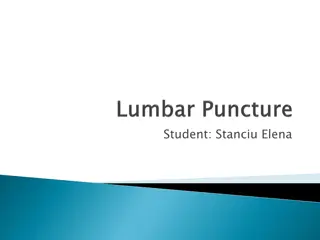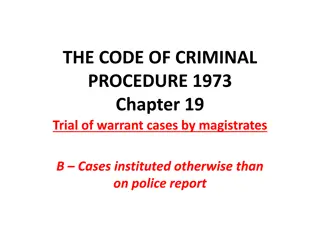Understanding Civil Procedure Rules Parts 18-23
The new civil procedure rules cover various aspects such as counterclaims, additional claims, changes to parties, representative parties, miscellaneous rules, and rules regarding minors and patients. The overriding objective is to ensure cases are dealt with justly and at a proportionate cost, considering factors like party equality, cost-saving, and efficient handling. Application for overriding objective by the court and specific rules for counterclaims and additional claims are outlined in detail.
Download Presentation

Please find below an Image/Link to download the presentation.
The content on the website is provided AS IS for your information and personal use only. It may not be sold, licensed, or shared on other websites without obtaining consent from the author. Download presentation by click this link. If you encounter any issues during the download, it is possible that the publisher has removed the file from their server.
E N D
Presentation Transcript
THE NEW CIVIL PROCEDURE RULES PARTS 18 - 23
What We Will Cover Part 18 - Counterclaims & Additional Claims Part 19 Addition & Substitution of Parties Part 20 Changes to Statement of Case Part 21 Representative Parties Part 22 Miscellaneous Rules About Parties Part 23 Minors & Patients 2
The Overriding Objective CPR 1.1 The overriding objective of these Rules is to enable the court to deal with cases justly and at proportionate cost. Dealing justly with a case includes, so far as practicable: a. Ensuring that the parties are on an equal footing; b. Saving expenses; c. Dealing with the case in ways which are proportionate to i. The amount of money involved; ii. The importance of the case ; iii. The complexity of the issues and; iv. The financial position of each party 3
The Overriding Objective contd d. Ensuring that it is dealt with expeditiously and fairly; e. Allotting to it an appropriate share of the court s resources, while taking into account the need to allot resources to other cases and; f. Enforcing compliance with rules, practice directions and orders. 4
Application for overriding objective by the court CPR 1.2 The court must seek to give effect to the overriding objective when a. Exercising any powers under these Rules; b. Exercising any discretion given to it by the Rules; or c. Interpreting these Rules. Any discretion which is exercised must give effect to the overriding objective. 5
PART 18 COUNTERCLAIMS & ADDITIONAL CLAIMS 6
Scope & Interpretation This Part applies to: - a Counterclaim by Def against the Claimant and someone else; - An Additional Claim by Def against someone for contribution or indemnity (whether party to proceedings already or not); and - Where an Additional Claim made against a non-party, any claims now being made by that non-party 7
Counterclaims A Defendant can still counterclaim in his Defence without leave. At any other time, leave is required. No need for Claimant to acknowledge service or intent to defend. (18.4) A Defendant who wishes to counterclaim against someone not a party, must get leave of Court to add them as an additional party. Applic may be exparte. Where Court gives leave, Ct must give directions as to mgmt of the case (18.5) Claim for Contribution or Indemnity Claim for Contribution or Indemnity A Defendant who has filed an Acknowledgment of Service or Defence who wants to make a claim for Contribution or Indemnity must file Notice containing statement of nature and grounds of his Additional Claim and serve on that party. (18.6) A Defendant making an additional claim for Contribution or Indemnity can do so without leave if: (i) he files and serves the Notice with his Defence OR (ii) where another party is added to the claim later, within 28 days of that new party filing its defence. At any other time, the Defendant must get leave of Court 8
The Additional Claim What is an Additional Claim? Per Part 18.1(2): any claim other than the claim by the Claimant against the Defendant or a claim for a set-off in the Defence Making An Additional Claim Claim is made when appropriate form filed. Particulars must be included in or served with the Claim Form No leave required once Additional Claim issued before or simultaneously with the Defence. Otherwise, leave of Court required May be made ex-parte unless court states otherwise 9
The Additional Claim (contd) Things to Note: Additional Claim generally treated like a Claim except as provided Time to serve a Claim form does not apply Default Judgments apply to Counterclaims but NOT Additional Claims Admissions apply to Counterclaims but only certain parts apply to Additional Claims Must serve additional claim of all parties when defence is served if it is a counterclaim, otherwise 14 days after filing. 10
Service of Counterclaim & Additional Claims Service of Claim Form (18.8) Where no leave was required and counterclaiming against an additional party only? Serve claim form on every other party to proceedings when serving your Defence. Where no leave was required and making an Additional Claim? Additional Claim must be served on the person against whom it is made within 14 days of issue. Where leave of Court was required? Court should give directions for service as part of its order. Effect of Service of an Additional Claim (18.10) Service of an Additional Claim makes a person a party to proceedings if he is not already. 11
Application for Leave to Issue an Additional Claim Per Practice Direction 18 an Applicant must file evidence setting out: (1)Stage of proceedings & timetable of claim to date (2)Nature of the Additional Claim or details of the question/issue to be decided (3)Summary of the facts on which Additional Claim is based (4)Name & address of proposed additional party (5)Explanation of any delay NB - Content of Additional Claim must be verified by Statement of Truth 12
Additional Claim or Separate Claim? Where Court is deciding whether to permit or dismiss an Additional Claim or to direct it be dealt with as a separate action, the Court must consider: (a) connection between the existing and Additional Claim & the claim of Claimant against the Defendant (i.e. the primary claim), (b) whether the additional claimant is seeking substantially the same remedy that some other party is claiming from him, and (c) whether the Additional Claimant wants the Court to decide any question connected with the subject matter of the proceedings (i) not only between the existing parties but also between the existing parties and someone who is not already a party; or (ii) against an existing party in some further capacity. (18.9) 13
Additional Claim & Default Judgment? Special provisions relating to Default Judgment (18.11) Provided the Additional Claim is not a Counterclaim or Claim for Contribution or Indemnity, a party served an Additional Claim who does not file an Acknowledgement of Service or a Defence to the Additional Claim is: - Deemed to admit the Additional Claim - Bound by any judgment or decision in the proceedings relevant to any matter in the Additional Claim. If Default Judgment given against an Additional Claimant, he can himself obtain judgment in respect of the Additional Claim by filing a request in the relevant practice form. The Additional Claimant will need leave to enter judgment under this section if he has not satisfied the Default Judgment that was given against him OR he wishes to obtain judgment for any remedy other than a Contribution or Indemnity 14
Service of Additional Claim Service on a Non-Party (18.12) When serving an Additional Claim form on someone who is not already party to the proceedings, you must also serve: (1) a form to defend the claim, (2) a form to admit the claim, (3) a form to acknowledge service, (4) a copy of every Statement of Case already served in the proceedings, (5) any other document(s) the Court directs. The Additional Claim form itself must also be served on all existing parties. 15
Defence Filed to Additional Claim? Case Management Where Defence Filed (18.13) Where a Defence is filed to an Additional Claim, the Court must case manage and give appropriate directions to ensure as far as practicable, the original claim and additional claims are managed together. Per Practice Direction 18 - When managing a Case, Court can exercise various powers. It may: (1) treat the case management like a summary judgment hearing (2) dismiss the Additional Claim (3) give directions re: dealing with the Additional Claim (4) give directions as to the part the Additional Defendant will take at trial (5) give directions re: the extent to which Additional Defendant is to be bound by any judgment or decision in the Claim. 16
PART 19 ADDITION & SUBSTITUTION OF PARTIES 17
Change of Parties (19.2) Claimant can add a new Defendant at any time before the Case Management Conference (CMC) without leave by filing an Amended Claim Form and Statement of Claim. - Rules applicable to service of claim will apply. - Note Rule 18 deals with Defendants adding additional parties. Court has power to add a new party without an application if desirable to resolve matters in dispute, or there is an issue involving the new party that is connected to the matters in dispute and desirable so that the Court can resolve that issue. Court can order any person cease to be a party if it deems it desirable. Court can order a new party to be substituted for an existing party if it feels matters in dispute can be resolved more effectively by substituting, the existing party s interest/liability has passed on to new party. Application can be made ex-parte but must be supported by affidavit evidence. 18
Change of Parties (19.2) Powers can be exercised at the CMC. Except by substitution, after the CMC, the Court cannot add a party on the application of an existing party unless the existing party can satisfy the Court the addition is necessary due to a change of circumstances that only became known after the CMC. Claimant can add a new Defendant at any time before the Case Management Conference (CMC) without leave by filing an Amended Claim Form and Statement of Claim. - Rules applicable to service of claim will apply. - Note Rule 18 deals with Defendants adding additional parties. 19
Adding & Substituting Parties Procedure (19.3) Court can add or substitute parties with or without an application. An existing party or even someone who wishes to become a party can make an application to add, substitute or remove a party. Where substituting a new party because existing party s interest or liability has passed to new party Evidence is requested by affidavit to satisfy them. A party cannot be added or substituted as a Claimant without their written consent being filed in the Registry. An Order adding, substituting or removing a party must be served on all existing parties, any party added or substituted, and any other person affected by the order. If the Court makes an order adding, removing or substituting a party, it must consider whether consequential directions regarding filing and service of documents and the management of proceedings going forward are necessary. 20
Adding or Substituting Parties after Limitation Special Provisions (19.4) After the relevant limitation period, the Court can only add or substitute a party if: (1) the relevant limitation period had not expired when proceedings were commenced, AND (2) Court satisfied the addition or substitution is necessary, that is: (i) the claim can t be properly carried on by or against an existing party without it, (ii) the interest or liability of the former party has passed to a new party, or (iii) the new party is to be substituted for a party named in the Claim form in mistake for the new party. 21
PART 20 CHANGES TO STATEMENT OF CASE 22
Changes to Statement of Case Changes to Statement of Case (20.1) Statement of Case can be amended once without leave prior to the CMC. Court can give leave to amend the Statement of Case at the CMC or at any time. In exercise of its powers, Court to consider: (i) promptness of application, (ii) prejudice to applicant and other parties, (iii) whether prejudice can be compensated by costs & interest, (iv) impact on the trial date and administration of justice. Rule reserves to the Chief Justice power add to list of factors to be considered Amended Statement of Case must include a Certificate of Truth. 23
NB - Changes to Statement of Case A Statement of Case may not be amended without leave under this rule if the change is :- (a) to add, substitute or change parties after the end of a relevant limitation period (Part 19.4) OR (b) being made to the statement of case after the end of a relevant limitation period (Part 20.2). If leave applied for, the court may allow amendment:- 1. Add / Sub new claim arising out of same or substantially same facts already claimed. 2. Correct a mistake as to name of party genuine and would not cause doubt as to the identity of the person. 3. Alter the capacity of an existing party 24
NB - Changes to Statement of Case contd Service of Amended Statement of Case (20.4) Where amended Statement of Case is served, a Defendant has 28 days to file and serve a Defence or amended Defence. Need to file an Amended Reply? You have 14 days. Haven t yet filed a Reply, you have 28 days. 25
Changes to Statement of Case After Expiration of Limitation Period (20.2) The Court can allow an amendment to: (1) Add/substitute a new claim if arises out of substantially the same facts, (2) Correct a mistake as to name of party provided the mistake was genuine and there was no real doubt as to identity of the party in question, or (3) Change the capacity in which a party is claiming. Circumstances where Court will allow a new claim to be added or substituted after the relevant limitation period addressed at Rule 19.4. 26
Practice Direction 20 Changes to Statements of Case Can apply to amend Statement of Case without an Oral Hearing if: - application is ex parte, - the parties agree no oral hearing is necessary, or - the parties have agreed the terms of an order. Need only file the application, supporting affidavit and copy of the proposed amendments. Amendments can be shown by successive coloured edits inserted by hand or by computer. Also have option of showing edits by use of numerical code in computer generated document. Where substantive change effected by the changes, then must re-verify by Statement of Truth. 27
Representative Parties Where 5 or more persons have same or similar interest in proceedings, Court can appoint a body or 1 of those persons to represent them all, whether Claimant or Defendant. Appointment of a Representative Claimant or Defendant (21.2) Application can be made at any time (even before proceedings begin) by any: (a) party, (b) person or body wishing to be appointed, or (c) anyone likely to be a party. Application must be supported by Affidavit setting out the parties and describing everybody Appointing a Representative Defendant? Must give Claimant notice. No notice necessary if appointing a Representative Claimant. Court can direct notice served on anyone it deems fit. 29
Representative Parties contd Where there is a Representative, any order of the Court binds everyone the Representative represents. However such an order cannot be enforced against someone who is not party to the proceedings without the leave of the Court. Application and affidavit must be served on persons against whom intended to enforce. 30
Representation of Parties Who Cannot be Ascertained Where proceedings concern a Deceased s Estate, Trust property, or Construction of a Written Instrument, the Court can appoint 1 or more persons to represent members of a class where members including cannot be readily ascertained, cannot readily be found or its expedient to do so. (21.4) Rep can be a claimant or defendant. Compromise in cases where 21.4 applies (21.5) Court has power to approve a compromise even where all parties interested or who may be affected are not parties provided they have a court-appointed representative, and the Court is satisfied the compromise will be for their benefit. 31
Representation of Parties Who Cannot be Ascertained Representation of Beneficiaries by Trustees (21.6) Claims can be made by or against a person in their capacity as trustee, executor or administrator. No need for a beneficiary to also be a party. Order will bind a beneficiary. Court may order that notice be given to any beneficiary if it wishes. Order will be binding on a beneficiary UNLESS trustee, executor or administrator could not or did not represent the interest of the beneficiary or alternatively, acted fraudulently. 32
Proceedings Against Estate of Deceased Person Where a deceased party had interest in proceedings but has no personal representative, the Court can appoint someone to represent the deceased s interests for the purposes of the proceedings. Criteria for Appointment As Representative of an Estate (21.7(2) A person can be appointed once they: (1) can fairly and competently conduct proceedings on Estate s behalf, and (2) have no interest adverse to the Estate of the deceased. Court can make the order of its own instance or on application. Claimant cannot take any further steps in proceedings until a representative appointed. However the Court can give directions to enable proceedings to continue if a party dies with or without an application. Where a Representative has been appointed a decision of the Court binds the Estate to same extent it would bind an executor or administrator. 33
Proceedings Against Estate of Deceased Person contd Power of Court to give Directions to Allow proceedings to continue after a party s death 21.8 Court can give directions to enable proceedings to continue if a party dies with or without an application 34
Proceedings Against Estate of Deceased Person Power of Court to Strike Out Claim After Death of Claimant (21.9) If a Claimant dies and the Claimant s Personal Representatives do not apply to be substituted as Claimants, the Defendant can apply to have claim struck out. Notice must be given to the Claimant s Personal Representatives and anyone else the Court directs General Rule - Court should make an Unless Order directing the Personal Representative or someone else of Estate s behalf: (1) to apply to be substituted as a Claimant, or (2) to apply for directions by a specified date, failing which the Claim is to be struck out. Court can give directions to enable proceedings to continue. 35
PART 22 MISCELLANEOUS RULES ABOUT PARTIES 36
Partners Partners (22.1) Persons claiming to be entitled or alleged to liable as partners may be sued in a firm name if: (1) that is the name of the firm in which they were partners, and (2) they were carrying on business in that name in the jurisdiction when the right to the claim arose. Obligation to Disclose Partner s Names (22.1(2) Partners suing or being sued in the firm s name must on written demand by any party file and serve a statement of names and home addresses of all partners in the firm who were partners at the time to the right to the claim arose. If they fail to comply, the Court can order disclosure. Where a party fails to comply with such an order within 21 days, any claim or defence brought by him is deemed struck out. Authorized Employee Acting (22.1(7) A duly authorized employee of a partnership or firm can conduct proceedings on its behalf or represent it in court with the Court s leave. Application for leave to be represented by an employee should be made at a case management conference. 37
Persons Carrying on Business in Another Name Person Carrying on Business in Another Name (22.2) A claim may be made by or against a person carrying on business in their own name or trading as XY , XY (a trading name) , or XY a firm . Where a claim is made by or against a person in his or her business name, the Rules about claims by or against partners apply as if that person had been a partner in a firm when the governing right to claim arose. Bodies Corporate (22.3) A body corporate needs an attorney to commence or carry on proceedings unless the Court permits it to be represented by an authorized Director or other Officer. Permission should be sought at the CMC or a pre-trial review. In making a determination, the Court should take into account all the circumstances including the complexity of the case. Must be authorized by the body corporate itself. 38
Appointment of a Litigation Guardian (LG) Requirement of a Litigation Guardian (23.2) General Rule is that Minor or Patient (or Person Under Disability ) must have a LG to conduct proceedings on his behalf. A Minor can apply to conduct his own proceedings without an LG. LG must be given notice if there is one. The Court can however subsequently appoint an LG if it appears desirable. An LG must act by attorney unless the Court orders otherwise. LG must sign a Certificate of Truth under Rule 3.8 on behalf of the Minor or Patient. 40
Stage of Proceedings when Litigation Guardian Necessary (23.3) A Minor or Patient must have an LG to start a claim unless he has secured leave to do so without one. A person cannot make an application against a Minor/Patient before proceedings have started. Where proceedings have started, until a Minor or Patient has an LG, a person cannot take any step in the proceedings except: (1) applying to have an LG appointed OR (2) issuing and serving a claim form against a minor or patient. If a person becomes a Patient during proceedings, until a LG is appointed, no party can take any further steps in the proceedings other than applying for the appointment of an LG. Any steps taken in proceedings before the appointment of a LG in contravention of these rules are of no effect unless Court otherwise orders. 41
Who Can be a Litigation Guardian For a Minor (23.4) For A Patient (23.5) Unless the Court has appointed someone else or removed that party, any party can act as a Minor s LG once the party satisfies the 23.6 Conditions. Unless the Court has appointed someone, any person authorized under the Mental Health Act to conduct legal proceedings can act. If no one appointed by Court or authorized under the Act then any party can act as a Patient s LG once the party satisfies the 23.6 Conditions. 42
Conditions for Being a Litigation Guardian CPR 23.6 A person may act as a litigation guardian if that person (a) Minor or Patient; and can fairly and competently conduct proceedings on behalf of the (b) has no interest adverse to that of the Minor or Patient. 43
Becoming An LG without Court Order Procedure (23.7) A person authorized under the Mental Health Act, must file copy of the Order or other document constituting his authority to act (the Authorization). Any other person must file a Certificate that they satisfy the conditions specified in 23.6. Acting for a Claimant? Must file the Authorization or Certificate when Claim is made Acting for a Defendant? Must file the Authorization or Certificate when taking first step in the proceedings on behalf of the Defendant. LG must also serve a copy of the Certificate on the Minor s parent, guardian or the person with whom the Minor lives. In the case of a Patient, must serve on anyone authorized by law to conduct proceedings on the Patient s behalf. Where no such person, then Claim Form must be served on the person with whom the Patient resides. 44
Appointment of LG By Court Order Procedure (23.8) Court can appoint an LG with or without an application. Any party to proceedings or any person who wishes to be appointed an LG can apply. If a person makes a claim against a person under disability who does not have an LG and (1) Someone who is not entitled to be LG files a Defence, or (2) the Claimant wants to take step in the proceedings, the Claimant MUST apply for the appointment of an LG. Application must be supported by affidavit evidence. Court cannot appoint an LG under this rule unless it is satisfied the person appointed complies with 23.6 conditions. 45
Termination of LG Termination by Court Order (23.9) Court has power to substitute, remove or bar someone from acting as LG on application or of its own instance. Applications must be supported by affidavit evidence. Applications to appoint, terminate, substitute, remove or bar must be served in compliance with Rule 5.10 which deals with service of claim on a minor/patient. Must serve the existing LG and the proposed new LG. Court can appoint any person. Appointment Ceasing (23.11) Unless a Minor is also a Patient, appointment of his LG ceases automatically upon his reaching the age of majority. If a Patient ceases to be a Patient during proceedings, the LG s appointment continues until ended by Court Order. The application for such an order may be made by any party, the former Patient or the LG and must be supported by affidavit evidence. 46
Termination of LG contd Where a LG s appointment ceases, the Minor or Patient must serve notice on all other parties providing inter alia: (i) his address for service, (ii) notifying them the appointment has ceased and (iii) indicating whether s/he chooses to carry on the proceedings. Notice must be served with 28 days of the LG s appointment ceasing failing which, the Court can on application, strike out any claim or defence filed by the Minor/Patient. The former LG s liability for costs continues until Notice that his appointment has ceased is served on the other parties either by the former Minor/Patient or the former LG himself. 47
Settlement/Compromise on Behalf of a Minor or Patient Compromise by or on behalf of a Person under Disability (23.12) Where a claim is made against a person under disability or on their behalf, any settlement, compromise, acceptance or payment of money is not valid without Court approval. Where a settlement of the claim is arrived at before proceedings are commenced and the sole purpose of proceedings is to secure Court approval of a settlement or compromise, that claim may be made by Fixed Date Claim (Form 2). The Fixed Date Claim form may be issued jointly by Claimant and Defendant and include a request for the Court to approve the settlement. Control of Money recovered on behalf of a Minor or Patient (23.13) Where money is recovered by or on behalf of or for the benefit of a Minor/Patient or is paid into Court for that purpose, a LG (or the Patient/Minor if the LG s appointment has ceased) must apply to the Court for directions as to how to deal with that money under this rule. Court can order that money be paid into Court and invested or otherwise dealt with. 48

 undefined
undefined








